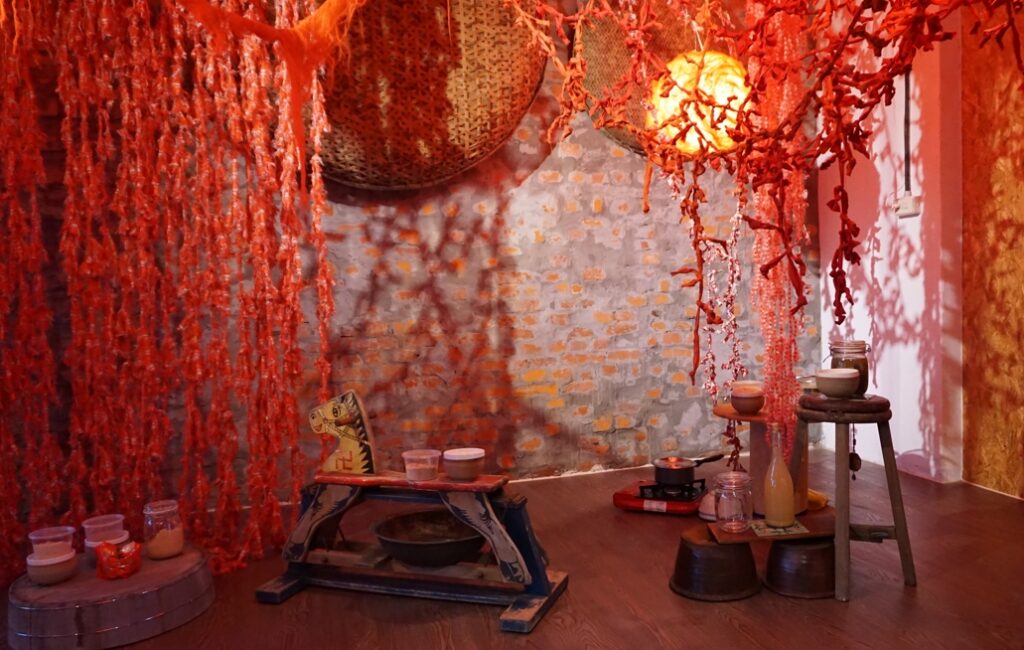集 Collection, Chia Hui Luo & Yi Ting Ho, Artists in Residence Exhibition

Chia Hui Luo & Yi Ting Ho, Artists in Residence Exhibition
以廷長期在「食」的領域裡,尋找、開發「嗅覺」與「味覺」的可能面向,除了著眼於常見食材自身的特性外,並重新審視它們與我們日常生活的連結關係,重新開發其可能性。嘉惠則是關注於非傳統媒材的日常棄物中「視覺」與「觸覺」方面材質意義轉譯的可能性。兩人迥然不同的專長,如何有跨域合作的可能?又會帶出什麼樣的作品呢?是雙方對於此次合作感到有趣的地方,究竟要從什麼點切入,才能讓彼此的合作連結與眷村日式老房「關係」呢? 「人去,樓不空」,老房面對一次又一次新人換舊人的景況,而進駐的每個人或多或少都有不同的囤積癖,「物之戀」不論內藏或外顯,可由個人對待周圍世界事物的態度與行為反映其個性與精神特色,反應其所關注的經驗、情感與文化。此次,藉著進駐眷村老房的創作機會,兩人個自對於「物」的不同觀察方式與想像連結將與替代空間裡前者所留下的「棄物」、「餘材」與負責人的「集物」做一個「念舊」、「戀物」的對話,讓物料、物件透過藝術表現手法轉化文化精神與內容,尋求其間「關係連結」的可能想像。 「觀察」向來是以廷生活裡的重要實踐,重新審視人的對「物」的理解方式,從改善人生活品質的觀點來重新檢視自然環境的重要性。以打開五感的角度出發,重新觀看人與生物、自然間錯綜複雜卻又密不可分的關係,只是人視而不見而將之忽略與遺忘,得以重新「連結」、「修復」人與自然的關係。對老房的觀察,正揭示了人與其生存環境間隨著時間流變而展開的相互關係。 使用「棄物」為材一直是嘉惠作品中的重要元素,碎布纏結連接成串的造形,是嘉惠予以抽象概念的「關係連結」一個具體化的符號,並將之帶入各個不同的空間場域中,思考與其間的人事物對話的可能性。代表意識的「結」是一種記憶與意識裡的「陳跡舊物」,沉潛在意識可能被輕易忽略的角落,但它們也猶如線索,循其軌跡才得以窺見原初的可能樣貌。 當我們試圖猜想老房的過去,或許正可以透過觀察生活裡的「殘痕」、「棄物」、「餘材」,從這些人跡印記裡去抽絲、剝繭、想像、連結這屋裡曾經被佇足的境況。而佇足在老房眼下的我們,也不是完全空白的,各自帶著自身過往經驗裡為這些殘痕、棄物、餘材所喚醒的記憶、想像來與之對話。
In the backdrop of a “heritage house,” it has undeniably seen a myriad of repeated “occupancies and departures.” And within that each process, its inhabitants’ personalities to inexorably store and stock according to their proclivities define and personify the identities of the house. The predilection to “collect” mirrors the two sides of a story—the attitude that one adopts and displays to the world reflects his/her inner proceedings and the psychological values and the experience and the emotions shaped within that temporal cultural value. Years of involvement in the cuisines have led Yi Ting on a quest to explore the complex potential of “smell” and “taste.” Focusing beyond the familiar physical properties of the commonly known ingredients and re-examining their perpetual association with our daily lives, the boundaries of that association can be deconstructed in order to be further understood and excelled. Chia Hui has instead focused on the waste we deemed disposable and re-evaluated their practicality by assigning them a new identity and status based on their “visual” and “tactual.” Combing their expertise of seemingly different disciplines, what possibilities could this collaboration potentially bring about? Perhaps the most interesting and crucial point is deciding where the starting ground is so that such two paradigms would be able to integrate, and expand reinforcingly in the context of “age,” which in this case, takes place inside a Japanese heritage house. Taking their observations, and expressing through the contemporary artistic methods, both artists attempt to explore the potential association and bring about a voice that is the personification of “the currently existed collectibles, the contrasting dispositioned, and the mysteriously abandoned.” “Observation” has always been an important method in life, in which contemplation occurs and the meaning of relationships is re-examined. Immersing in the world’s natural orders, through the engagement of our five sensory organs, Yi Ting has found that the relationships between men and nature are intricately woven and inseparable, yet deceptively ignored and forgotten. In an attempt to revisit and revive the intra-relationships between men and the inter-relationships between men and nature, perhaps the key is to rethink the values and the quality of life adopted by men and how the natural environment played a crucial part in shaping them. The observation of the old house brings out the analogy of man and his environment and how such relationship has unfolded and evolved through time. Reusing the “waste” has always been the central theme to Chia Hui’s works. The knots created by tying the fabrics together are her most abstract way of representing the “relations” in a cause and effect manner. The knots are further the old conscious constituents of the past memory that may be easily overlooked and forgotten, but also act as clues as to why through what may have been the most original to begin with. When efforts are made to picture the heritage house’s past, the only yielding clues are the “wears and tears,” the “disposed,” and the “abandoned,” which are uniquely pertinent within that space. It is also only through these dusty footprints that we gingerly pick up and retell the fragmented stories to what was once a piece of lively and forgotten memory.
Yi Ting has created flavorful powders of his childhood flavor memories:
1. Osmanthus distillate/蒸餾桂花純露
2. Indian olive aroma/錫蘭橄欖所散發的自然香氣
3. Koji mold on the apple wedges/蘋果培養的米麴霉
4. Fermented Koji rice with congee/發酵米麴粥
5. Chicken noodle soup with black sesame oil/黑麻油雞湯麵
6. Stewed pork’s knuckle/燉豬蹄
7. Kimchi/泡菜
8. Fermented star fruit drinks/發酵楊桃汁
9. Homemade stinky tofu/自製臭豆腐
10. Peanut flavored mocchi/花生口味麻糬
11. Puffed black sesame rice crispy/黑芝麻麻荖
12. Root beer/沙士
13. Hawaii pizza/夏威夷披薩
14. Popcorn with butter and cheddar flavor/奶油起司爆米花
Collection (Chia Hui Luo & Yi Ting Ho, Artists in Residence Exhibition)
Loc.: Kaohsiung
Opening: Jan. 19, 2020 (14:00)
Date: 2020/1/19-2/8